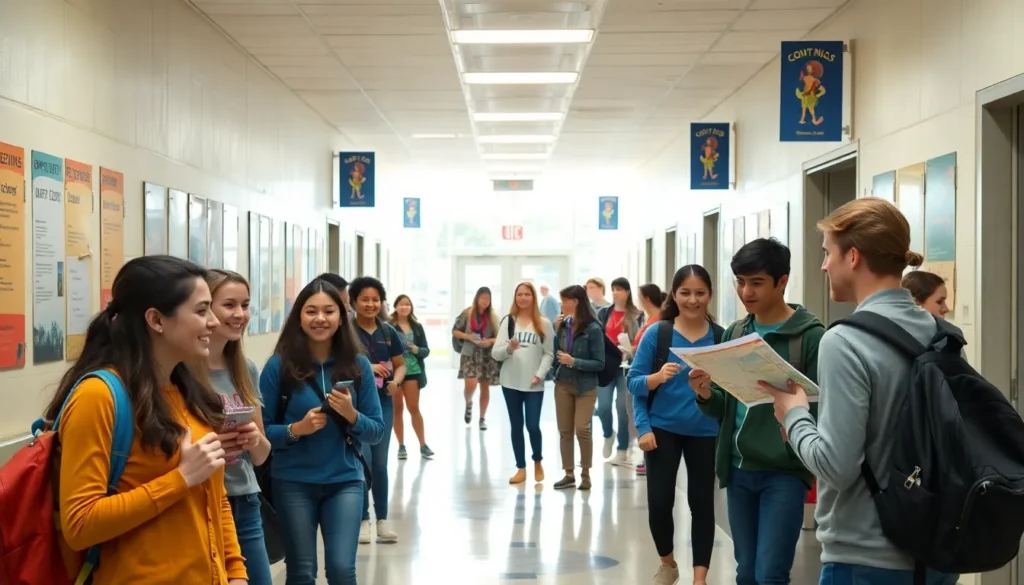Table of Contents
ToggleStarting high school can feel like stepping into a whole new world. For many students, high school orientation serves as the crucial first step in this exciting journey. It’s not just a chance to learn about school policies and meet teachers; it’s an opportunity to connect with peers and get a feel for the vibrant community that awaits.
Orientation sets the stage for a successful high school experience. Students gain insights into academic expectations, extracurricular activities, and the overall culture of the school. With the right preparation, they can navigate the transition with confidence, ensuring a smoother start to their high school adventure.
What Is High School Orientation?
High school orientation serves as an introductory event for students transitioning into high school. This essential program ensures students understand school policies, academic expectations, and available resources. Students connect with teachers, establish relationships with peers, and start building a network within the school community.
During orientation, students explore extracurricular activities, giving them insight into clubs, sports, and other organizations. Orientation also includes tour opportunities, allowing students to familiarize themselves with the campus layout and key facilities, like the library, cafeteria, and gym.
High school orientation helps foster a sense of belonging. Students receive information about schedules, grading systems, and support services. This event ultimately prepares students for the challenges and opportunities ahead, promoting a positive start to their high school experience.
Importance of High School Orientation

High school orientation plays a crucial role in setting the foundation for a successful high school experience. It offers significant advantages for both students and parents.
Benefits for Students
- Familiarity with the Environment: Orientation familiarizes students with campus layout and key facilities. They tour the school, locate classrooms, the library, cafeteria, and gym, ensuring confidence on the first day.
- Understanding Expectations: Orientation clarifies academic expectations, grading systems, and school policies. Students receive essential information about course requirements and assessment methods.
- Social Connections: Orientation provides opportunities for students to meet peers and form friendships. Engaging in icebreakers and group activities fosters a sense of belonging from the start.
- Exploration of Activities: Orientation showcases extracurricular activities such as clubs and sports. Students can explore interests and find opportunities to participate, enhancing their high school experience.
- Resource Awareness: Orientation introduces students to support services like counseling and tutoring. They learn about available resources that can help them navigate challenges.
Benefits for Parents
- Familiarization with School Dynamics: Orientation helps parents understand school policies, academic standards, and procedures. They can ask questions and gather information directly from educators.
- Building Communication Channels: Orientation establishes connections between parents and school staff. It opens lines of communication that are essential for ongoing support and engagement.
- Involvement Opportunities: Orientation highlights ways for parents to get involved, such as volunteering and attending events. This engagement fosters a strong school community and partnership in their child’s education.
- Support System Understanding: Orientation informs parents about resources available for their children. Knowledge of counseling and academic support services enables them to assist their students effectively.
- Confidence and Reassurance: Orientation provides reassurance to parents about the transition. Understanding what to expect helps ease concerns, promoting a positive outlook on their child’s high school journey.
Preparing for High School Orientation
Preparation for high school orientation is essential for a seamless transition. Knowing what to expect and what to bring can enhance the overall experience.
What to Expect
Expect an informative session during high school orientation. Orientation typically includes a welcome address from school administrators, a brief overview of academic programs, and an introduction to key staff members. Students participate in guided tours, which showcase essential areas like the gymnasium, cafeteria, and library. In addition, they engage in icebreaker activities designed to encourage social interactions with new classmates. Schools may also present details about important policies, grading systems, and support services available, setting a solid foundation for students.
Recommended Items to Bring
Bring several key items to high school orientation for optimal readiness:
- Personal Notebook: Taking notes during presentations helps retain important information.
- Writing Utensils: A pen or pencil is vital for jotting down notes and filling out forms.
- Water Bottle: Staying hydrated is important during the day, especially during activities.
- Schedule: Having a copy of the student’s class schedule aids in planning and navigating the campus.
- Parent Contact Information: Keep essential contact details accessible for easy communication with school staff.
- Backpack: A sturdy backpack can help carry notes, schedules, and any materials distributed during orientation.
- Comfortable Shoes: Since orientation involves walking, wearing comfortable footwear supports better mobility throughout the day.
Being prepared with these items ensures students make the most of their high school orientation experience.
Tips for a Successful Orientation Experience
Success at high school orientation relies on active engagement and familiarity with the school environment. Following these tips can significantly enhance the overall experience.
Engaging with Staff and Peers
Engagement with staff and peers builds vital relationships. Students should:
- Ask Questions: Inquire about academic expectations and available resources. Clarifying doubts early fosters understanding.
- Participate Actively: Join group discussions and icebreaker activities. Active participation promotes connection and rapport.
- Introduce Themselves: Taking the initiative to meet teachers and classmates establishes a network and eases future interactions.
- Share Interests: Discuss personal interests during interactions to find common ground with peers and develop friendships.
- Express Enthusiasm: Demonstrating enthusiasm about subjects and activities invites positive responses from both staff and fellow students.
Navigating the Campus
- Take Notes During Tours: Document key locations like classrooms, restrooms, and offices for easy reference later.
- Utilize Maps: Refer to campus maps provided during orientation to visually understand the layout and locate important areas.
- Explore Facilities: Visit the library, cafeteria, gym, and other facilities to become acquainted with available resources and amenities.
- Practice Routes: Walk between class locations during orientation to build confidence in navigating the campus independently.
- Ask for Directions: Engaging with school staff or older students for directions reinforces communication skills and aids in finding specific locations confidently.
High school orientation serves as a crucial foundation for students embarking on their academic journey. By fostering connections and familiarizing students with their new environment, orientation sets the stage for a successful high school experience. Engaging with peers and staff not only builds confidence but also cultivates a sense of belonging.
Preparation and active participation during orientation can significantly enhance this experience. Students who embrace the opportunities presented during this event are likely to navigate their high school years with greater ease and enthusiasm. Ultimately, a positive orientation experience can make all the difference in shaping a student’s path ahead.





